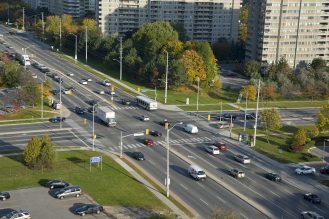The City’s new Transit and Road Infrastructure Plan provides a blueprint for implementing a long-term rapid transit and road network in Mississauga over the next 20 years. It will also help position the City to seek funding from the Provincial and Federal governments.
October 23, 2025
The plan will guide the City’s actions, policies and investment in Mississauga’s transit and road network over the next 20 years. As Mississauga continues to grow, there is a need for a multi-modal transportation system that is safe, quick and efficient. The TRIP will guide Mississauga to prioritize transportation infrastructure more effectively, helping people reach their destinations as efficiently as possible, regardless of the mode of transportation they use. It will also help protect vulnerable road users like pedestrians, cyclists and transit users.
Long-term transit network recommendations
The long-term transit network will help grow future transit ridership while providing connections to rapid transit projects currently under construction within the city, as well as to regional transit systems (such as GO Transit) and regional destinations. The recommended transit infrastructure will help reduce transit delays, improve travel time and service reliability.
The recommendations fall into three categories based on how many people are expected to use it, available space and making sure access to transit is equitable. The categories are:
- Higher order transit: These are the busiest routes where transit solutions like Bus Rapid Transit (BRT) or Light Rail Transit (LRT) run in their own dedicated lanes.
- Transit-only lanes: These are busy routes where adding special lanes along the curb for buses will help transit move more efficiently.
- Intersection improvements: For many routes, improving intersections can help make transit more reliable and provide better connections.
Long-term road network recommendations
Roads are necessary for connecting to new development areas, crossing major barriers and moving goods around the city. Building new roads or improving existing roads can also help expand connectivity for transit, walking and cycling. Most road improvements in the plan are intended to accommodate transit priority projects.
Sometimes roads may need to be rebalanced to make room and improve safety for vulnerable road users, like pedestrians and cyclists. This could mean adding a new sidewalk, installing protected bike lanes or adding a left turning lane. Before any changes are made, the City will study the road and ask for feedback from the community to help shape the final designs for the road.
Learn more and read the Transit and Road Infrastructure Plan: mississauga.ca/projects-and-strategies/city-projects/transit-and-road-infrastructure-plan/
Background
In the City’s first Transportation Master Plan, endorsed by Council in 2019, a vision was established that “everyone and everything will have the freedom to move safely, easily and efficiently to anywhere at anytime.” The Transportation Master plan is an overarching guide on the future of transportation in Mississauga.
In 2020, the City initiated a study called the Transit and Road Infrastructure Plan to build upon the vision of the Transportation Master Plan and address two of its action items:
- To update the long-term transit network plan
- To update the long-term road network plan
Quote
“Most people in Mississauga drive as their primary mode of transportation to get around the city. Over time, our transportation system has been built to support travel by car. As the demand in Mississauga grows, we are reaching a physical limit to expanding our road network. We need transit and road improvements to support a growing Mississauga. Having this new Transit and Road Infrastructure Plan in place will help guide us over the next 20 years in prioritizing transit and road infrastructure projects that move people safely, easily and efficiently, regardless if they’re walking, cycling, taking transit or driving. With Council endorsing the Transit and Road Infrastructure Plan, the City will be better positioned to seek funding from the Federal and Provincial governments for future rapid transit projects.” – Sam Rogers, Commissioner, Transportation and Works


